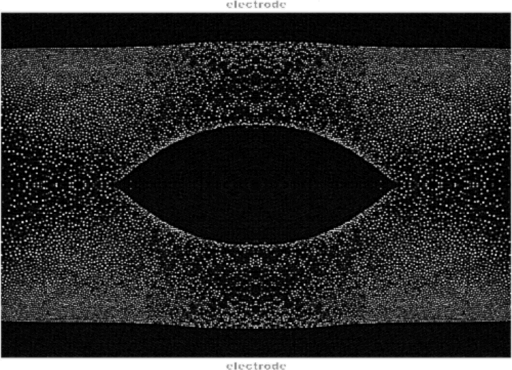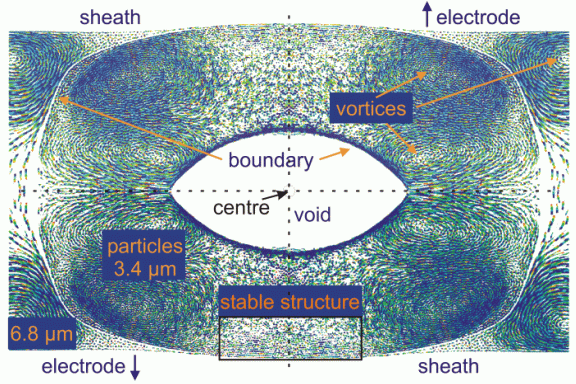|
|
A complex plasma in microgravityPKE-Nefedov, as a laboratory installed on the International Space Station, is operative since the beginning of 2001. In total 11 missions with 36 separate experimental runs of 90 minutes each have been performed. It is the most actively used scientific apparatus on the ISS with a scientific outcome of more than 15 refereed publications (Jan. 2005).Under normal gravity conditions only small complex plasma systems of limited extent in the vertical direction - a few lattice layers - can be investigated (in a region where gravity is compensated by a strong electric field). In weightlessness (microgravity) we observe large complex plasma systems extended in all three space co-ordinates (see figure 1). It can be shown that under microgravity conditions much broader and different regions in the parameter phase space are accessible, providing means for researching new physics not attainable under gravity conditions.  Figure 1: Typical appearance of a complex plasma in microgravity with PKE-Nefedov.  Figure 2: Features of a complex plasma (3 seconds superposition of particle trajectories)
Under microgravity conditions the typical static and dynamic behaviour of
complex plasmas is illustrated in figure 2. This figure shows a 3
second trajectory fragment of the microparticles, color coded from red to
blue. The dominant features which can be investigated here are:
The void: The microparticle free centre between the electrodes can be explained by the equilibrium of all forces acting on the particles. Since the dominant force on earth, gravity, is reduced by orders of magnitude the weaker forces can be investigated in detail. These forces are the electrostatic force FQ arising from an electric potential with a maximum in the centre, which decreases radially and axially, and the ion drag force Fid. The latter is due to the acceleration of the positive ions along this electric field out of the centre and the resulting friction force on the particles. According to the well known formula by Barnes et al., the ion drag force is too low to overcome the electrostatic force to form the void. A major result of the microgravity experiments has been the rederivation of the ion drag and the discovery of new processes that change the "classical" result by over a factor 10. The experimental results agree with the new theory. Since ion drag is of great importance in many physical situations and problems, the new insights gained from these experiments on the ISS have to be considered as a major achievement. The void can be closed under special experimental conditions. These conditions are neutral gas pressures below 0.5 mbar and the lowest possible rf-voltages, close to the plasma-off condition. At these parameters the plasma density is so low and the electric field is so weak that finally the electrostatic force dominates over the ion-drag force, and the particles are pushed to the centre. Void/complex plasma boundary: The equilibrium of the above mentioned (opposite) forces gives the radial position of an isolated microparticle. In a particle cloud, there are pressure forces, too. The sharp boundary cannot be explained by the equilibrium position alone. It was discovered that the complex plasma changes the potential distribution in such a way that a sheath with a so-called double layer is formed. This double layer produces a change in the sign of the electric field and can explain the sharp edge. This phenomenon, well known to occur in plasma-wall interactions, is apparently present, even if the "wall" is extremely porous (in our case only about 10-4 of the surface is "solid"). Demixing of different particle sizes: The forces are size dependent. FQ ~ a and Fid ~ a2, where a is the radius of the particle. This results in an equilibrium position of smaller particles which is closer to the centre than that of bigger ones, easily explaining the observed demixing of the different sizes. The new physics is therefore not the fact of demixing - it lies in the way how de-mixing proceeds in strongly coupled plasmas. This topic is being actively pursued with new dedicated experiments on the ISS. For now it is sufficient to mention that the approach to final equilibrium can pass through a new universal process (a non-equilibrium coordinate space phase transition) not known previously - a process peculiar to strongly coupled systems.  Crystalline structures: In many crystallisation experiments
with PKE-Nefedov, we observed crystalline order in a small area close
to the sheath region. Even after several minutes the size of the crystal
did not increase. In one of the latest experiments, we injected
particles with a diameter of 3.4 μm at a pressure of 0.24 mbar.
A few minutes after the injection, when the complex plasma has
reached a steady state, the pressure was reduced in little steps
down to 0.14 mbar. Every step causes a little "puff" of gas, which
disturbs the equilibrium position of the particles. These little kicks
precipitate an annealing of crystal defects, so that a large crystalline
region is formed, filling the whole area between void and sheath and
between the vortices at the border of the complex plasma. This special
condition made it possible, for the first time, to observe the crystal
structure with the high resolution CCD camera. A scan in depth provided
us finally with a 3-dimensional view of the crystal.
Crystalline structures: In many crystallisation experiments
with PKE-Nefedov, we observed crystalline order in a small area close
to the sheath region. Even after several minutes the size of the crystal
did not increase. In one of the latest experiments, we injected
particles with a diameter of 3.4 μm at a pressure of 0.24 mbar.
A few minutes after the injection, when the complex plasma has
reached a steady state, the pressure was reduced in little steps
down to 0.14 mbar. Every step causes a little "puff" of gas, which
disturbs the equilibrium position of the particles. These little kicks
precipitate an annealing of crystal defects, so that a large crystalline
region is formed, filling the whole area between void and sheath and
between the vortices at the border of the complex plasma. This special
condition made it possible, for the first time, to observe the crystal
structure with the high resolution CCD camera. A scan in depth provided
us finally with a 3-dimensional view of the crystal.In contrast to crystals with similar particles under normal gravity it was found that in space the crystal planes where not mainly oriented parallel to the electrode. Using a vertical cut of the particle positions obtained from a scan with the high resolution camera through the crystalline area, one can see that the crystal consists of domains with different orientation and different crystalline structure (see fig. right). This allows us to investigate the physics of 3-D domain boundaries, de-excitation of lattices, annealing etc. at the kinetic (individual particle) level. Vortices: In the boundary regions the trajectories of the particles show a vortex like motion. This is caused by strong electric field inhomogeneities which occur at the edge of the electrodes and at the interface between the electrodes and the particle dispensers. These in turn affect the forces FQ and Fid, causing the particle cloud to execute a convective-like motion. Although this motion is poorly controlled, it nevertheless provides interesting insights into the kinetics of shear flows - some of the phenomena observed will therefore become subject of special investigations in the future. For future experiments (see PK-3 Plus) the plasma chamber and electrode assembly have been changed so that a much better symmetry and homogeneity of the electric field between the electrodes is achieved and therefore the vortex motion does not occur. In PK-4 the design criteria include special studies of controlled shear flows as a major goal. More results (2)... |
|
|